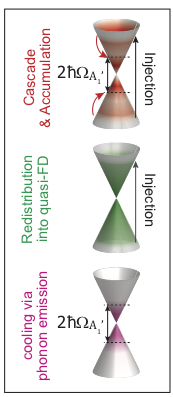Abstract
Time- and angle-resolved photoemission spectroscopy (TR-ARPES) accesses the electronic structure of solids under optical excitation, and is a powerful technique for studying the coupling between electrons and collective modes. One approach to infer electron-boson coupling is through the relaxation dynamics of optically excited electrons, and the characteristic timescales of energy redistribution. A common description of electron relaxation dynamics is through the effective electronic temperature. Such a description requires that thermodynamic quantities are well-defined, an assumption that is generally violated at early delays. Additionally, precise estimation of the nonthermal window—within which effective temperature models may not be applied—is challenging. We perform TR-ARPES on graphite and show that Boltzmann rate equations can be used to calculate the time-dependent electronic occupation function f(ε,t), and reproduce experimental features given by nonthermal electron occupation. Using this model, we define a quantitative measure of nonthermal electron occupation and use it to define distinct phases of electron relaxation in the fluence-delay phase space. More generally, this approach can be used to inform the nonthermal-to-thermal crossover in pump-probe experiments.
